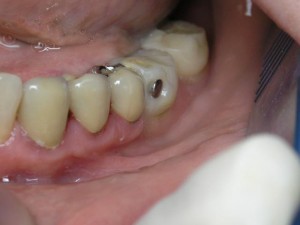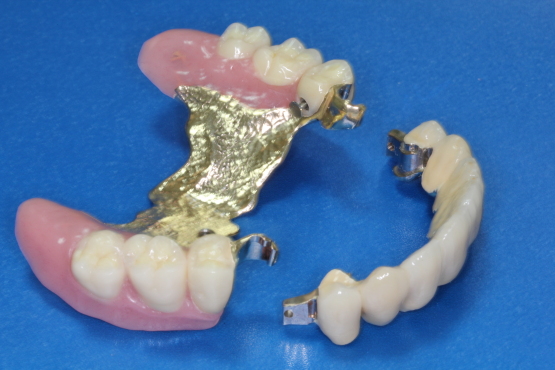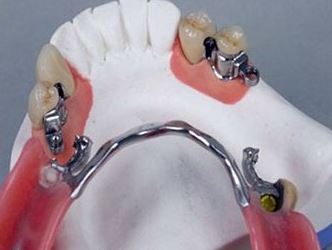Reviews of clasp dentures on locks

In recent years, arch prostheses have become one of the most popular among removable structures.
The attractiveness of the system is due, first of all, to the fact that the prosthesis provides an even distribution of the load when chewing on the supporting teeth and gum mucosa.
Among other advantages of the design, it can be distinguished that the system has a sufficiently long service life, is convenient to use, and looks aesthetically pleasing and compact.
In dental practice, designs with the following type of fixation are widely used:
- Clammed prostheses.
- Structures on locks or attachments.
- Dentures on telescopic crowns. It is used if the height of the crowns or the shape of the teeth does not allow the installation of an orthopedic design on them.
With arch prosthetics with a lock type of fixation, attachments (locks) are not visible from the outside, which adds aesthetics to the smile.
The metal parts of the locks are successfully masked inside the clasp system. One part of the lock is mounted on the crown of the supporting tooth, and the other on the prosthesis itself. When donning the structure, the locks snap into place.
Unlike prostheses on clasps, the design with a lock fastener has less mobility, which increases the load on the supporting teeth, and, as a result, can cause them to loosen.
Advantages and disadvantages

The advantages of locking are:
- The ability to replace the matrix.
- The duration of the fastening service.
- The possibility of repairing the castle.
- Quick getting used to the prosthesis.
- Excellent operational and esthetic qualities.
- Precision of manufacturing construction.
- Reliability of prosthesis fixation.
Among the disadvantages of clasp prostheses on the locks, the following disadvantages can be distinguished:
- Lock fasteners can only be fixed on ceramic-metal crowns. Four crowns are usually made.
- The clasp design on the locks is one of the most high-tech in dentures. The manufacture of a prosthesis requires highly qualified personnel.
- High cost of construction with a lock type of fastening.
- Some types of attachments (made of plastic) require regular replacement, approximately once every two years.
- Repair of locks is too expensive if they break.
- To install a clasp prosthesis on the locks, it may be necessary to depulpate healthy teeth.
Types of locks
Depending on the topography of the defect in the dentition, various types of locks can be used:
- Rotational Attachments.
- Rigid locks.
- Hinged locks.
Castle structure

- The castle consists of a matrix and a patrician.
- The matrix is mounted on a ceramic-metal crown, and the patrician is attached to a clasp structure.
- For the lock to close, one of the parts must be inserted into the other.
More recently, locks have appeared that can be attached with a composite to the enamel of the abutment tooth, but the reliability of such an attachment is questioned.
When not to install
The use of clasps with attachments is not possible in the following cases:
- In the presence of defects in the tissues of the supporting teeth.
- If the clinical crowns of teeth are low.
- Attachment placement on fangs and incisors is not recommended.
Video: “Denture with a lock”
Reviews
Despite the disadvantages of locking, the prosthetics with clasp structures on attachments are now popular. After all, removable dentures on the locks create a complete feeling of having your own teeth.
Reviews of clasp dentures on the locks are proof of this.
- Last year, I installed a clasp prosthesis with a lock. I really didn’t want others to see that I had a false jaw. The disadvantage of prosthetics is that it was necessary to put cermet on four healthy teeth, it turned out that this was necessary. It is convenient to use the prosthesis, the structure is perfectly fixed, there is no discomfort.
- Five years ago, I lost a few teeth, and I wanted to install implants. But, since bone tissue has atrophied over the years, implantation has become irrelevant. In the dental clinic, I was offered to install a clasp prosthesis with lock fixation. To fix the crowns, the doctor turned his abutment teeth. At the time of manufacture of permanent crowns set temporary. A week later, the ceramic-metal crowns, on which the part of the castle is located, on the clasp construction, respectively, were put on the supporting teeth, respectively, the second. During the installation of the prosthesis, the attachment fastens and holds very tightly artificial teeth. I got used to the prosthesis quickly, there was no discomfort, the structure is tightly fixed, it does not interfere with the conversation and during meals. Aesthetics on top.
- Two years ago I wanted to install implants. But, due to the fact that implantation is a rather expensive service, the dental clinic recommended restoration of teeth using arch prosthetics. For a long time I chose between the design on the clasps and the one on the attachments. As a result, I chose the castle clasp prosthesis. They installed four metal-ceramic crowns with attached parts of locks. When putting on the prosthesis, the other part of the lock located on the clasp is connected to the one on the crown and closes tightly. As a result, the prosthesis is very stable, does not move, does not slip, does not affect diction. I got used to new teeth very quickly. The only minus is my healthy honed teeth under the crowns.
- A month ago, they installed a clasp structure on attachments on the lower jaw. Immediately there was an unpleasant sensation from the fact that the metal arc presses so that it hurts to move the tongue. All mucous swollen, painful. I went to the dentist, he slightly corrected the arc, it became much easier. I had to go to the doctor’s appointment one more time for correction. Now everything is fine, I’m getting used to the prosthesis. The structure holds firmly, does not shift during eating, but so far I still perceive it as a foreign body.
- I had severely damaged several teeth, so much so that only the roots remained. I was going to remove them and install implants. A little expensive, of course, but there is no other way. In the clinic, where I turned, I was asked to install the clasp on the locks. Live teeth roots served as the basis for crowns with a castle part. The other part of the castle, respectively, is on the prosthesis. When installing the prosthesis, the parts of the locks are connected and snap into place. As a result, the structure is very firmly held in the mouth. During prosthetics, all procedures were easily transferred. Some inconvenience appeared after three and a half years. I went to dentistry, where the prosthesis was installed, they corrected it.I continue to use the design.